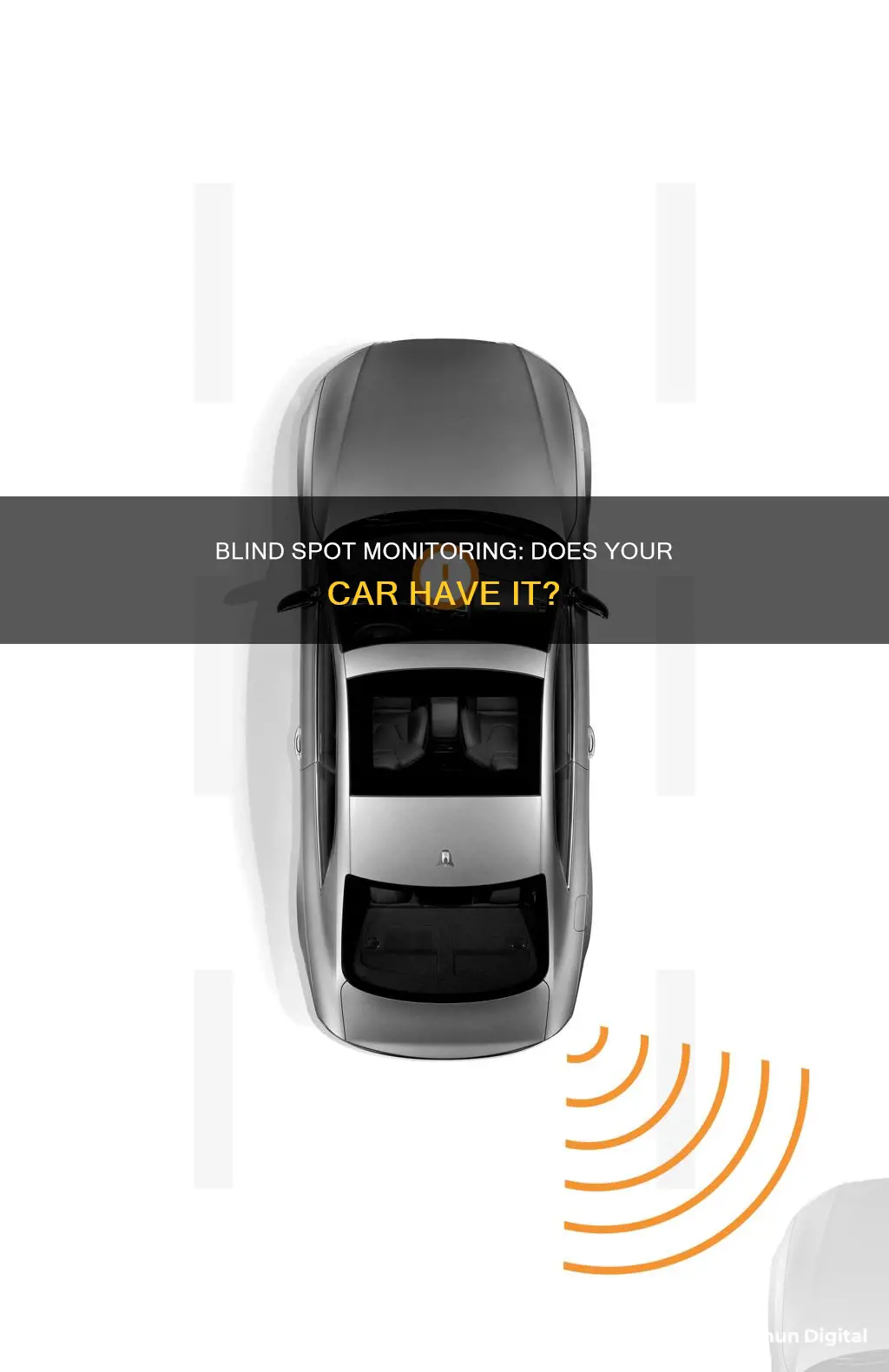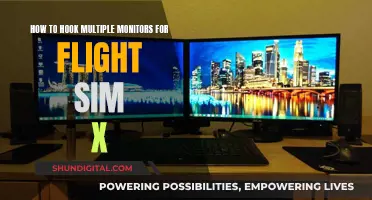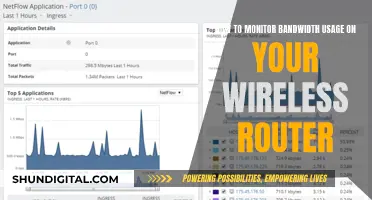
Blind-spot monitoring (BSM) is a safety feature that alerts drivers to vehicles in their blind spots, helping to prevent lane-change accidents and collisions. It is particularly useful for larger vehicles, which tend to have bigger blind spots, and can also be beneficial for new or nervous drivers. BSM was once a feature reserved for high-end luxury cars, but it is now available at every price point, either as a standard feature or as an optional add-on. If your car doesn't have BSM, it is possible to add it as an aftermarket feature, with kits available from retailers like Amazon, Walmart, and Crutchfield, and car manufacturers such as Jeep, Ram, and Kia offering OEM upgrades.
| Characteristics | Values |
|---|---|
| Purpose | Warns the driver of vehicles in their blind spots |
| Warning Types | Symbol, sound, vibration, light, chime |
| Detection | Radar, ultrasonic sensors, sonar, lidar, cameras |
| Installation | Professional, DIY |
| Cost | $300 to $500 for a solid system |
| Benefits | Increased safety, driver confidence, all-around awareness, reduced insurance costs |
What You'll Learn
- Blind spot monitoring systems can be added to older vehicles
- There are two main types of aftermarket BSM systems: sensor-based and camera-based
- BSM systems can improve driver confidence and reduce stress
- BSM can be purchased from Amazon, Walmart, and Crutchfield, among others
- BSM systems can cost between $300 and $500

Blind spot monitoring systems can be added to older vehicles
Blind Spot Monitoring (BSM) systems can be added to older vehicles. Aftermarket BSM systems are a perfect addition to older vehicles that lack certain types of technology. These systems can increase driving awareness, prevent crashes, and relieve stress while driving.
Aftermarket BSM systems use sensors to monitor a vehicle's blind spots and alert the driver of potential dangers. These sensors can be mounted on side mirrors or the rear bumper and typically use radar, sonar, or lidar technology. Some systems also employ cameras inserted into side mirrors to provide a visual of the blind spot.
When choosing an aftermarket BSM system, it is important to consider the accuracy of the sensors and the ease of installation. Professional installation is recommended, but it is also possible to install the system yourself with the help of an instruction manual.
The cost of aftermarket BSM systems varies, with more expensive systems offering higher accuracy and advanced features. It is important to research the different options and choose a system that meets your specific needs and vehicle requirements.
Overall, adding a BSM system to an older vehicle can significantly improve safety and provide drivers with valuable assistance.
Asus VG248QE Monitor: Performance and Features Review
You may want to see also

There are two main types of aftermarket BSM systems: sensor-based and camera-based
Blind-spot monitoring (BSM) is a safety feature that keeps an eye on the space just off the rear quarter areas of your vehicle. This feature is especially useful for larger vehicles with bigger blind spots.
Aftermarket BSM systems are a great addition to older vehicles that may not have this technology built-in. They can increase driving awareness, assist drivers of larger vehicles, prevent crashes, and increase response time. These systems are universal and can be installed in vehicles of any age, make, or model.
When choosing an aftermarket BSM system, it is important to consider the type of sensors and indicators included in the kit. Most kits include visual LED lights and an alarm, but some may offer additional features such as volume control. Professional installation is recommended, but it is also possible to install these systems yourself with the help of online resources and the kit's instructions.
Bloomberg's Monitor Setup: Size and Configuration Explained
You may want to see also

BSM systems can improve driver confidence and reduce stress
Blind Spot Monitoring (BSM) systems are an effective way to improve driver confidence and reduce stress while on the road. BSM systems are designed to assist drivers in detecting vehicles in their blind spots, which are areas around the vehicle that are not directly visible to the driver, typically towards the rear sides. By alerting drivers to potential hazards, BSM systems offer a host of benefits that contribute to a more relaxed and assured driving experience.
Firstly, BSM systems provide drivers with increased awareness of their surroundings. The system acts as an additional set of eyes, constantly monitoring spots that the driver may not be able to track while driving. This is especially useful for drivers of larger vehicles, who often struggle with limited visibility. BSM technology helps identify blind spots, reducing the stress of driving a larger vehicle and ensuring a more confident journey.
The real-time feedback offered by BSM systems empowers drivers to make more informed decisions. By receiving timely warnings about potential dangers, drivers can prevent accidents and develop safer driving habits. This proactive safety measure not only reduces the risk of blind-spot accidents but also enhances overall safety on the road. The early warning system increases response time, allowing drivers to take appropriate action and avoid dangerous maneuvers.
BSM systems also offer convenience by automatically monitoring blind spots, so drivers can focus on the road ahead. This feature is especially beneficial when navigating busy traffic and changing lanes, as BSM systems provide alerts through visual or auditory cues. The integration of BSM with other safety technologies, such as lane departure warning systems, further contributes to a comprehensive safety net for drivers.
Additionally, BSM systems are customizable to suit individual preferences. Drivers can adjust the sensitivity, volume, and type of alerts, or even disable certain features as per their requirements. This flexibility allows for a tailored driving experience, ensuring drivers feel confident and in control.
While BSM systems offer significant advantages, it is important to acknowledge their limitations. Environmental factors, such as extreme weather conditions or obstructions, may impact the accuracy and reliability of the system. False alarms are also possible, triggered by temporary obstructions or adjacent vehicles. Despite these challenges, BSM technology continues to evolve, with advancements in sensor technologies and algorithms enhancing accuracy and reliability.
LCD, LED, and TFT Displays: Understanding Differences
You may want to see also

BSM can be purchased from Amazon, Walmart, and Crutchfield, among others
Blind-spot monitoring (BSM) is an active driver aid that helps prevent accidents by alerting you of potential hazards in your blind spots. If your car didn't come with BSM, you can purchase an aftermarket BSM kit from retailers like Amazon, Walmart, and Crutchfield. These kits typically cost between $300 and $500 and can be professionally installed for at least $200.
Amazon offers a wide range of BSM kits, with various features and price points. Some kits include a car blind spot camera paired with a display system, while others offer ultrasonic sensors or radar detection systems. Amazon also has universal BSM assistants that use a 24GHz millimeter-wave sensor to detect vehicles in your blind spot and provide a lane-changing warning.
Walmart and Crutchfield also offer similar BSM kits, providing options for those who prefer to shop at different retailers or may find better deals. It's always a good idea to compare prices and features to ensure you're getting the best product for your needs.
When choosing a BSM kit, consider the type of sensors, the accuracy of the system, and the type of alerts provided. Some kits may offer visual alerts, while others may have audible alarms or a combination of both. Additionally, ensure that the kit is compatible with your vehicle and consider professional installation for the best results.
Mirroring Android to LCD: Easy Ways to Connect and View
You may want to see also

BSM systems can cost between $300 and $500
Blind Spot Monitoring (BSM) systems are a useful safety feature that can prevent accidents and increase a driver's awareness of their surroundings. They are particularly helpful when changing lanes on a motorway or highway, as they can warn the driver when another vehicle is in their blind spot.
BSM systems typically operate via external sensors located on a car's bumpers and wing mirrors. When these sensors detect a person or vehicle in the driver's blind spot, they notify the driver via an audible or visual cue, such as a warning light on the wing mirror or an alarm.
While BSM was once only found in high-end luxury cars, it has now trickled down to economy cars, with some models even including it as a standard feature. If BSM isn't standard, it's often available as a stand-alone option or as part of an option package.
The cost of BSM systems can vary depending on their features and functionality. Basic BSM systems can be found for under $250, while mid-range systems typically cost between $300 and $500. These mid-range systems offer higher accuracy than the basic systems, but they are still not as accurate as factory-installed BSM systems in new vehicles.
For those seeking the highest reliability and accuracy, high-end BSM systems cost $500 or more. These top-tier systems utilise advanced controller programming to reduce the possibility of false alarms, resulting in higher accuracy.
It's worth noting that the installation of BSM systems may incur additional costs. While some BSM kits can be installed by the vehicle owner, professional installation is often recommended and can cost at least $200.
Best Vertical Monitors to Buy: Ultimate Guide
You may want to see also
Frequently asked questions
Check your car manual or look for sensors, usually quarter-sized round indentations, in the bodywork or fascias.
Blind-spot monitoring uses sensors or cameras to detect vehicles, objects, or people in your blind spots and alerts you with a symbol, sound, or vibration.
Yes, you can install an aftermarket blind-spot monitoring system. These systems typically cost between $300 and $500, plus installation costs if you don't install it yourself.







